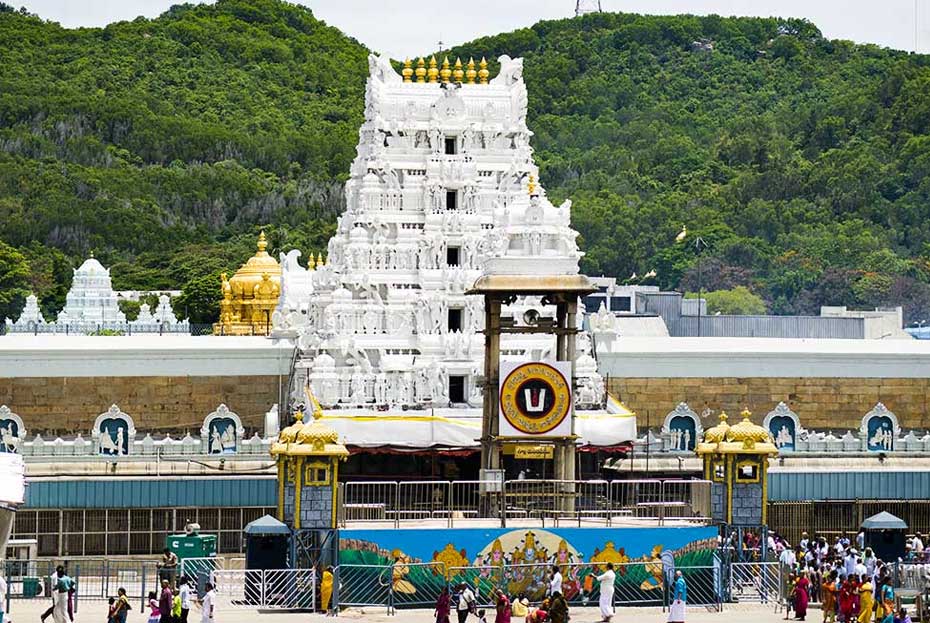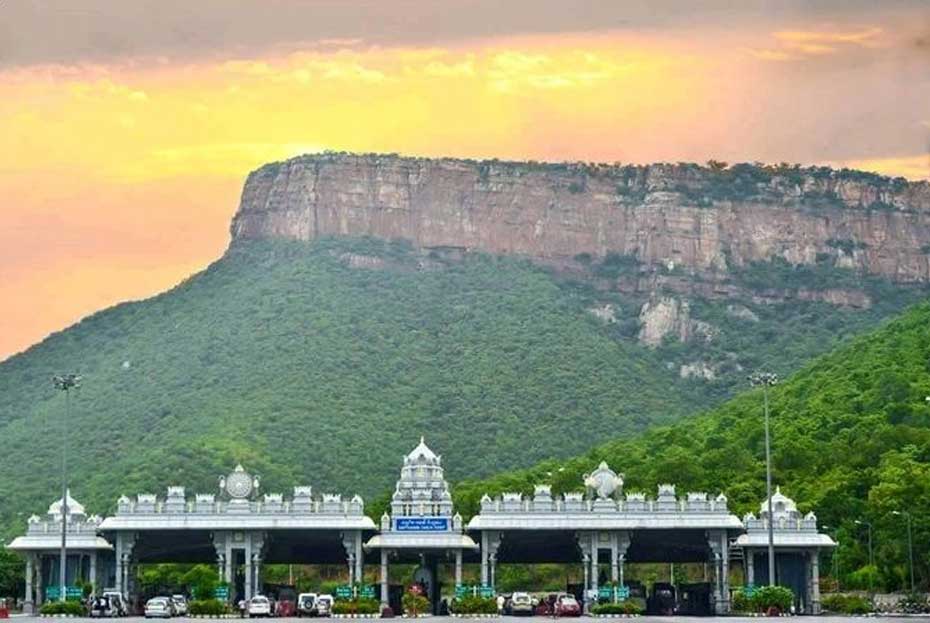Sri Venkateswara Swamy Temple Tirumala
🖼️ Photo Gallery



🛕 Temple Info
Sri Venkateswara Swamy Temple, located on Tirumala Hills near Tirupati in Andhra Pradesh, is one of the most sacred and visited Hindu temples in the world. It is dedicated to Lord Venkateswara, an incarnation of Lord Vishnu, also known as Balaji, Govinda, or Srinivasa.
The temple is renowned for its spiritual significance, Dravidian architecture, and immense wealth, receiving millions of devotees and donations every year. The main idol is believed to be self-manifested (Swayambhu) and highly powerful. Key practices include tonsuring (hair offering), Laddu prasadam, and participation in daily sevas and grand festivals like Brahmotsavam.
It is managed by the Tirumala Tirupati Devasthanams (TTD) and offers both free and special entry darshans, with extensive facilities for pilgrims.
💫 Importance
1. Spiritual Significance
- Lord Venkateswara is believed to be the Kaliyuga Avatar of Lord Vishnu, who descended to Earth to guide and protect humanity in the current age of Kali Yuga.
- It is said that a visit to Tirumala and a glimpse of Lord Balaji grants moksha (liberation) from the cycle of rebirth.
- Millions of devotees make pilgrimages every year to seek the Lord’s blessings, often fulfilling vows, donating their hair (tonsure), or performing sevas (ritual offerings).
2. Mythological Importance
- Mentioned in sacred scriptures like the Bhavishyottara Purana, Varaha Purana, and Padma Purana.
- The temple is believed to be situated where Lord Vishnu manifested in the form of Venkateswara, who married Padmavati (an incarnation of Goddess Lakshmi) at this sacred spot.
- The hill itself, Seshachalam, is considered divine as it’s associated with Adisesha, the serpent mount of Vishnu.
3. One of the Richest Temples in the World
- Receives crores in donations every year, including gold, cash, and jewelry.
- Devotees donate tons of gold and other wealth out of gratitude and devotion.
- The temple also manages several charitable initiatives in education, healthcare, and social welfare through TTD (Tirumala Tirupati Devasthanams).
4. Global Pilgrimage Center
- One of the most visited religious sites globally, attracting 50,000 to 100,000+ visitors daily, and millions during festivals like Brahmotsavam.
- The temple symbolizes unity in diversity, with pilgrims from across India and abroad, cutting across caste, creed, and language.
5. Cultural & Architectural Importance
- A magnificent example of Dravidian temple architecture with a golden dome (Ananda Nilayam) over the sanctum.
- Home to ancient rituals, music (Annamacharya kritis), dance, and scriptures.
- Hosts several traditional festivals and ceremonies, preserving age-old Vedic practices.
6. Symbol of Devotion
- Rituals like hair tonsuring, Thulabharam, and offering donations are considered powerful acts of surrender to the divine.
- It’s a place where people make vows, seek healing, success, and peace.
- Even people of other faiths visit out of reverence.
📜 History
Ancient Period (9th–13th Century):
- The earliest recorded history dates back to the 9th century, during the Pallava dynasty.
- Later, Chola and Pandya kings contributed to temple expansion and worship practices.
Medieval Period (13th–16th Century):
- The Vijayanagara Empire, especially under King Krishnadevaraya, played a major role in enhancing the temple's wealth and fame.
- Krishnadevaraya is said to have donated gold, commissioned temple gopurams, and ensured structured temple management.
- Inscriptions on temple walls from this era detail various donations, rituals, and royal patronage.
British Colonial Era (18th–19th Century):
- Under the British, the temple was managed by Mahants (religious heads) from the Hathiramji Mutt.
- British East India Company regulated the temple income under the Board of Revenue but did not interfere in rituals.
Modern Administration – TTD (1932 onwards):
- In 1932, the Tirumala Tirupati Devasthanams (TTD) was formed under the Andhra Pradesh Charitable and Hindu Religious Institutions and Endowments Act to oversee temple affairs.
TTD introduced transparency, pilgrim services, education, healthcare, and technology integration in temple management.
🪔 Pooja Timings
| Pooja/Seva Name | Approximate Timing | Description |
| Suprabhatam | 3:00 AM – 3:30 AM | Wake-up call to the Lord with sacred hymns |
| Thomala Seva | 3:30 AM – 4:00 AM | Decoration of the deity with garlands |
| Archana | 4:00 AM – 4:30 AM | Recital of 1,008 names of the Lord (Ashtottara Shatanamavali) |
| Koluvu | 4:30 AM – 5:00 AM | Accounting ritual; offerings and temple finances are presented symbolically |
| First Sarvadarshanam | Starts after 5:30 AM | General public allowed for darshan |
| Kalyanotsavam | 10:30 AM – 12:00 PM | Celestial wedding ceremony |
| Unjal Seva | 1:00 PM – 2:00 PM (weekly) | Lord is placed on a swing (Unjal) and rocked with music |
| Sahasra Deepalankarana | 5:30 PM – 6:30 PM (daily) | Evening ritual with 1,000 lamps and devotional dance/music |
| Ekantha Seva | Around 9:00 PM | Lord is laid to rest; final ritual of the day |
🚌 Transport Options
1. By Train (Rail)
- Nearest Railway Station: Tirupati Railway Station (TPTY)
- Well connected to major cities like:
- Chennai, Bangalore, Hyderabad, Vijayawada, Mumbai, Delhi
- From Tirupati Station:
- Buses, taxis, and private vehicles are available to Tirumala (22 km)
2. By Air
- Nearest Airport: Tirupati International Airport (TIR) – about 40 km from Tirumala
- Connected to:
- Hyderabad, Chennai, Bangalore, Delhi, Vishakhapatnam
- From airport to Tirumala:
- Cabs, autos, and APSRTC buses available
3. By Road (Bus/Car)
- Tirumala is connected by a well-maintained Ghat Road to Tirupati.
- Two Ghat roads (one for uphill, one for downhill) are open 24/7.
- APSRTC buses (state transport) and private taxis run frequently from:
- Tirupati Railway Station
- Tirupati Bus Stand
- Airport
- Direct buses also run from:
- Chennai, Bangalore, Hyderabad, Vijayawada
4. On Foot (Pilgrimage Walk)
Two footpaths (used by pilgrims walking to Tirumala):
- Alipiri Mettu (longer, 9 km – ~3,550 steps)
- Open 24/7
- Starts at Alipiri (base of Tirupati)
- Srivari Mettu (shorter, 2.1 km – ~2,400 steps)
- Open from 6:00 AM to 6:00 PM
Free luggage transport and tokens for darshan are provided at entry.
Local Transport in Tirumala
- TTD buses (free & paid) for commuting within Tirumala.
- Cabs and autos are also available.
- Private vehicles are allowed but require a vehicle check and permit at Alipiri Toll Gate.
🏙️ Nearby Cities
| City | Distance from Tirumala | Travel Time (Approx.) | Notes |
| Tirupati | 22 km | 30–45 mins (road) | Nearest major city; base for Tirumala pilgrimage |
| Chittoor | 70 km | 1.5 – 2 hours | District HQ of Tirupati, well connected by road |
| Nellore | 135 km | 3 – 3.5 hours | Coastal city, connected by rail/road |
| Kadapa | 140 km | 3 – 3.5 hours | Historical city, good rail connectivity |
| Vellore (TN) | 110 km | 2.5 – 3 hours | Tamil Nadu city; known for medical and educational institutions |
| Chennai (TN) | 150 km | 3.5 – 4 hours | Nearest metro city with airport access |
| Bangalore (KA) | 250 km | 5 – 6 hours | Well connected by road and train |
| Kanchipuram (TN) | 180 km | 4 – 5 hours | Famous temple town in Tamil Nadu |
MytempleMypride Reflection
Written by MyTempleMyPride, with inputs from local devotees and traditional stories.